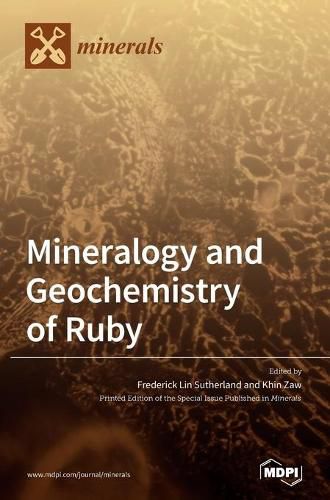Readings Newsletter
Become a Readings Member to make your shopping experience even easier.
Sign in or sign up for free!
You’re not far away from qualifying for FREE standard shipping within Australia
You’ve qualified for FREE standard shipping within Australia
The cart is loading…






This title is printed to order. This book may have been self-published. If so, we cannot guarantee the quality of the content. In the main most books will have gone through the editing process however some may not. We therefore suggest that you be aware of this before ordering this book. If in doubt check either the author or publisher’s details as we are unable to accept any returns unless they are faulty. Please contact us if you have any questions.
Ruby, red corundum, is a gem mineral with mineral properties, gem characteristics and chemistry that are reliant on critical trace element substitutions in its aluminum oxide crystal structure. Ruby has attracted scientific and economic interest. It has already been studied extensively regarding its widespread global distribution and the diversity of its geological associations, as revealed by exploration and exploitation. Researchers are becoming increasingly aware that geographic typing of ruby characteristics and its host assemblages may guide further exploration and provide checks on reputed sources of both rough and cut stones. Genetic pointers, based on fluid and solid mineral inclusions, oxygen and other isotope values and pressure and temperature estimates, have already yielded much genetic information. Rare ruby in mantle xenoliths, TP 1100o C, 2GPa, epitaxial diamond in ruby and ruby in diamond have special interest. Amid the present extensive documentation on this singular gem mineral, new insights and co-existing associations remain to be discovered. Although ruby largely appears in metamorphic and metasomatic source rocks, newer studies suggest it may also arise from magmatic sources. Age-dating of a range of mineral inclusions in ruby now allows more precise modelling of ruby genesis. Tectonic aspects of ruby genesis related to early collisional plate events on Earth are also a frontier for further understanding. In addition, ruby growth remains an important phase in metamorphic studies of events in some young collisional zones. This Special Issue planned for Minerals aims to attract further studies on this multi-origin gem mineral. Investigations at the ‘economic border’ of ruby and sapphire nomenclature and relevant treatments affecting ruby color will be considered.
$9.00 standard shipping within Australia
FREE standard shipping within Australia for orders over $100.00
Express & International shipping calculated at checkout
This title is printed to order. This book may have been self-published. If so, we cannot guarantee the quality of the content. In the main most books will have gone through the editing process however some may not. We therefore suggest that you be aware of this before ordering this book. If in doubt check either the author or publisher’s details as we are unable to accept any returns unless they are faulty. Please contact us if you have any questions.
Ruby, red corundum, is a gem mineral with mineral properties, gem characteristics and chemistry that are reliant on critical trace element substitutions in its aluminum oxide crystal structure. Ruby has attracted scientific and economic interest. It has already been studied extensively regarding its widespread global distribution and the diversity of its geological associations, as revealed by exploration and exploitation. Researchers are becoming increasingly aware that geographic typing of ruby characteristics and its host assemblages may guide further exploration and provide checks on reputed sources of both rough and cut stones. Genetic pointers, based on fluid and solid mineral inclusions, oxygen and other isotope values and pressure and temperature estimates, have already yielded much genetic information. Rare ruby in mantle xenoliths, TP 1100o C, 2GPa, epitaxial diamond in ruby and ruby in diamond have special interest. Amid the present extensive documentation on this singular gem mineral, new insights and co-existing associations remain to be discovered. Although ruby largely appears in metamorphic and metasomatic source rocks, newer studies suggest it may also arise from magmatic sources. Age-dating of a range of mineral inclusions in ruby now allows more precise modelling of ruby genesis. Tectonic aspects of ruby genesis related to early collisional plate events on Earth are also a frontier for further understanding. In addition, ruby growth remains an important phase in metamorphic studies of events in some young collisional zones. This Special Issue planned for Minerals aims to attract further studies on this multi-origin gem mineral. Investigations at the ‘economic border’ of ruby and sapphire nomenclature and relevant treatments affecting ruby color will be considered.